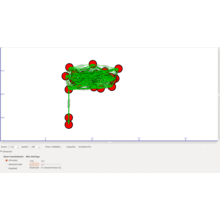This page is about to give detailed research updates on final year project ideas for networking student. A network is a group of computer systems arranged with or without any proper design and framework. Basically, the network does not require any predefined framework; it creates the link among nodes at run-time and makes every node engage in the network. For the purpose of routing, the node themselves act as a relay to transfer data from source to destination. In the case of moving nodes, it creates a temporary connection to transfer data from one node to another.
As a matter of fact, the current technological advancements of wireless networking and cellular communication are combined together to create the revolutionary changes in the human life and standards. Let’s see how they create the beneficial impact on society in the followings,
- In the modern world, wireless communication has become an inseparable part of human life. For instance: the internet and smartphone.
- In our daily life, wireless network has contribution in the form of wireless communication. It enables people to share data from any remote location at any time. In order to establish this data transmission, it supports routing, security, and networking protocols for the distributed network.
In general, there are two types of networks. One is an infrastructure network, and the other is an infrastructure-less network. The great growth of various real-time applications proportionally increases the demand for infrastructure-less networks. Further, these future technologies are expected to meet the requirements of the following,
- Runtime varying network structure
- Fast interactive/response system
- Distributed network architecture
In order to support wireless networking research and development, numerous applications, protocols, and platforms were established. On using them, numerous applications were developed for both individual and commercial purposes. This makes the final year students move in the direction of networking research dissertation ideas and projects. For the benefit of interested students, here we have given few tips to choose the best networking project topic.

How to Choose a Final Year Project Topic for Networking Students?
- As a final year student, you have conceptually learned many subject areas. From that, select an interesting topic that has future scope.
- Detect the list of current research issues related to real-time applications
- Prepare the list of possible research topics for your final year project
- Handpick the one among them
- Collect all available resource materials
- Propose the optimal solutions to tackle the issue
Prior to choosing the research topic, make yourself familiar with networking fundamentals with their recent challenges and research issues. We provide numerous Final Year Project Ideas for Networking Student. Now, let’s see about the responsibilities of networking in communication. Based on the below functions, only the data is transmitted between sender and receiver.
How does data transmission works in networking?
- Deploy the sensors based on location and areas for data collection
- Distribute the control message in the network (gossiping and flooding)
- Transmit the data to the destination
- Achieve the quality of services by means of energy utilization, delay, throughput, and reliability
On knowing the importance of networking, our research team has conducted an exhaustive study on recent research areas of the networking field. From that, we have found out the few open challenges that are common to many research areas. In addition to these challenges, we have spotted out many critical research issues in top-demanding areas.
Open Challenges of Networking
- Limited Bandwidth – All the nodes share the same bandwidth
- Location-based Conflict – Distribute the traffic load over the network
- Node Mobility – Random movement of nodes may leads to packet collision, link breakdowns, lack of resource accessibility
- Shared Frequency Band and Error-prone – Increase the error rate
- Other Resource Restriction – Battery power, buffer storage and processing power
Furthermore, we have also highlighted the research issues facing each layer of the networking model. Generally, the data transmission is occurred through passing the following layers. Each layer has its own characteristics and functions to operate on networking and communication. So, it comprises more technical challenges to execute in real-world scenarios. Below, we have given a few of them based on the networking layers. These issues also give more final year project ideas for networking students.
Research Issues on Networking Layers
- Physical
- Channel Coding
- Radio Frequency Circuits
- Modulation Types
- Data Link (MAC and LLC)
- Channel Assignment
- Multi-Access
- Link Error Control
- Network
- Node Movement Control
- Rerouting
- Transport
- Traffic Control
- Retransmission
- Middleware and Operating System
- QoS and Power Management
- Link breakdown Control
- Services and Application
- Context Adaptation
- Digital Signal Processing
- Source Coding and Precoding
- Task Segmentation
Next, we can see the major classification of wireless networks. In the place of a classic wired network, now the wireless network is placed due to its fast and portable access. Though it has some security threats, it is popularly used in many real-time and non-real-time applications. In this wireless network, there are two primary classifications as cellular/mobile and ad-hoc networks. Let’s see them in detail,
Major Two Types of Wireless Networking
Wireless Cellular Network
- It is an infrastructure network. i.e., fixed framework
- In this, the base station and cell sites are pre-located
- Further, the network structure is static and predefined
- Ensure the balanced connectivity in the relative network
- For instance: LTE, Edge network, 5G network, Heterogenous network, etc.
Wireless Ad-Hoc Network
- It is an infrastructure-less network. i.e., dynamic framework
- In this, it has no base station and enables fast deployment
- Further, the network structure is dynamic which support multi-hop
- Provide unbalanced connectivity in the messy environment
- For instance: SPAN, VANET, IMANET, WANET, Tactical MANET, etc.
As a matter of fact, the majority of final year project ideas for networking students are recognized in the above areas. Further, these areas are narrow down into several sub-areas. Our resource team constantly updates their skills in all these areas. Additionally, we also support you in other enabling technologies of networking. Below, we have listed out few important research notions of networking collected based on the current final year’s student’s interests.
Top 10 Final Year Project Ideas for Networking Students
- Energy-Aware Computing Methods for Managing Networked Models
- Enhancement of Data Accessibility and Reliability in Networked Systems
- Improvement of Data Acquisition and Storage Techniques in RAN
- Efficient Query Processing and Analysis
- Advance Scheduling and Resource Control in Large-scale Network
- Secure Data Caching and Storing in Decentralized System
- Cognitive Radio-based Spectrum Sensing and Allocation
- Efficient Routing Techniques for Traffic Control
- Design of New Security and Privacy Approaches for Wireless Communication
- Enhanced Analysis and Debugging Mechanisms in Networked Systems
Performance Evaluation of Networking
Next, we can see about the development side of the research topic. The primary decision you have to make in the development phase is a selection of the tool. For that, you choose one among testbeds, emulator, and simulator based on the requirement of the project. All these development platforms are suitable for various environmental scenarios. So, you have to select the best-fitting one that sure to yield the best results. Overall, each one has different capabilities to work under different circumstances. The most common platforms used in networking developments are given as follows,
- Simulators
- Analytical modeling
- Real platforms
- Testbeds
In this, researchers/students highly prefer wireless simulators. We provide numerous final year project ideas for networking student in wireless domain. Since it provides end-to-end supports to build, develop, and test the network, it also enables the analysis of the network’s performance and behavior. Similarly, testbeds provide testing environments. It is specially launched for conducting network experiments prior to real deployment. In this, it enables you to design any size of the network range from small to large regardless of complexity. From the beginning, testbeds are intended to test and evaluate the network research.
For instance: protocols, software, embedded systems, platforms, tools, etc. Depends on this, it assesses the particular event of the network in the testing environment, for example, energy efficiency, protocols design for different layers, node mobility, conceptual models needed for simulation, etc.
Testing the performance of the network.
One should do a comprehensive analysis of the available tools before choosing appropriate tools for your code development phase since each tool has its own characteristics, architecture, models, and frameworks for testing the performance of the network.
If there is a requirement, we can even combine the different tools with supporting testbeds, simulation, emulation, and modeling in one place. So that you can design networks, validate the algorithm, apply proofs-of-concept and assess performance in networks. Here, we have given the common tools and technologies from the networking project development platforms.
- Simulation / Modeling – Prowler, VisualSense, NS2, Castalia, OMNet, etc
- Real Implementation – Telos-family motes, Mica-family motes, etc.
- Testbed – ORBIT, Emulab, Sensorscope, Motelab, etc.
- Emulation – ATEMU, Avrora, TOSSIM, Emstart, etc.
What is QoS?
- QoS represents the experience gained by the user on using the network services.
- Support ranking based connections for network routing
- Subjected to minimize data loss, delay, jitter, etc. for the purpose to assure high performance
- take account of massive architectures, technologies, and protocols
Here, we have given the importance of the QoS factor in networking. This clearly explains what makes QoS one of the most important factors in performance evaluation and the main objective of the QoS in networking.

Why is QoS Significant?
- The main objective of the QoS is to provide custom based services for applications with an assurance of enough bandwidth and minimum data loss and latency
- Due to high internet access, the network has more traffic which is mostly based on IP
- Further, employing one transport protocol is more advantageous in providing network services
- For instance: best-effort service is the internet’s transport service
In addition, we have given the core functionalities in provisioning QoS. This helps you to realize how the QoS is achieved in networking. Also, how it improves the performance of networking in different applications.
QoS of Networking
Furthermore, our developers have shared the Quality of Services (QoS) of the networking. Since QoS is the main factor in assessing the network performance, we can predict and improve the network performance through this. For any network project, the weightage of the proposed schemes is evaluated through this QoS factor. In order to compute the QoS value, it has certain parameters used to evaluate network performance based on the project requirements.
QoS Provisioning of Networking
- Generally, QoS need concession in admission control, priority-based packet scheduling, resource conservation, host/network, etc.
- Based on the QoS metrics, the optimal route can be selected for transmission. And the metrics are latency, packet loss ratio (PLR), packet delivery ratio (PDR), bit error rate (BER), etc.
- Moreover depends on the requirement; the metrics may differ. For instance: WSN – low energy usage and battery lifespan, Military Defense – security, bandwidth, reliability, latency, etc.
- In overall, the QoS framework intended to deliver the assured service through the modules like resource control, signaling protocol, and routing protocol.
Next, we can see the few vital techniques that have a key player role in enriching the QoS in networking. For illustration purposes, we have bulletined few major networking operations with their QoS improving techniques. Similarly, we also guide you in other techniques to enhance the QoS factors for accomplishing maximum network performance.
QoS Enhancement Techniques
- Packet Scheduling
- Priority Queuing, FIFO, WFQ
- Traffic Monitoring and Shaping
- Token and Leaky Bucket
- Resource Conservation
- RSVP
- Admission Control
- Flow Acceptance or Rejection
Last but not least, now we can see the metrics used to evaluate the QoS of the network. All these are collectively referred to as QoS parameters to measure the network efficiency during simulation.
Network QoS Parameters
- Transmission Latency (idle time between sender and receiver)
- Throughput (low data rate)
- Latency Jitter (variation in transmission latency)
- Reliability Degree (least no.of.users to avail data)
- Error Rate (data loss)
In order to complete your final project, you need the original topic and best guidance team, along with sophisticated infrastructure and resource material. On making a bond with us, you can avail of all these services from one place. On the whole, we assure students that we surely help achieve your project goal in networking.
For the ease of students, we mandatorily provide final year project ideas for networking student, project source code (explanation), hardware & software requirements, software installation procedures, project screenshots, and project running guidelines and video at the time of project delivery.

 Click Here to watch our latest output video using NS3 simulator
Click Here to watch our latest output video using NS3 simulator  Click Here to watch our latest projects screenshots using NS3 simulator
Click Here to watch our latest projects screenshots using NS3 simulator